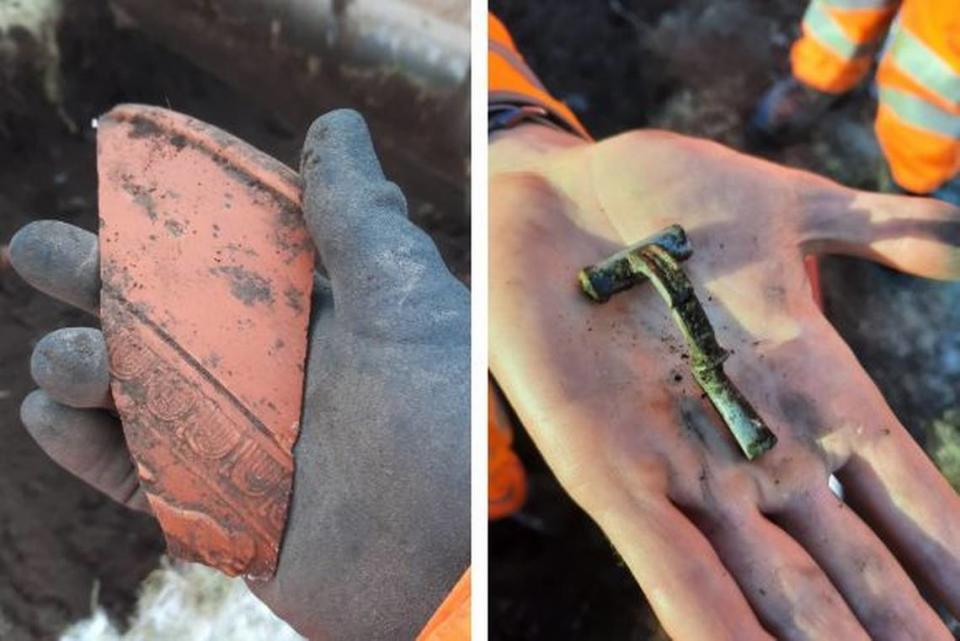Highway work reveals ‘luxurious’ Roman artifacts. See the nearly 2,000-year-old finds
As part of upgrades to a highway in northwestern England, archaeologists have been excavating a route that has been used by humans for at least 10,000 years.
Now, three months into their excavations, the team is sharing the first finds from their “groundbreaking exploration” in Cumbria, some of which potentially date back up to 6,000 years, according to a Feb. 29 news release from National Highways.
Among their discoveries, archaeologists found an abundance of evidence from the Roman influence in ancient England. They explored farmsteads and small villages along what was a Roman road about 2,000 years ago.
As one half of #OCAArchTeam, we're up in Cumbria with @OATweet, uncovering Cumbrian history dating back 6,000 years! The #A66 project covers a routeway that's been in use for nearly 10,000 years, so we're excited but not surprised. We're only halfway through the trenching, and… pic.twitter.com/Km925EFaBC
— Cotswold Archaeology (@CotswoldArch) March 11, 2024
Uncover more archaeological finds
What are we learning about the past? Here are three of our most eye-catching archaeology stories from the past week.
→ Emerald green artifact 'ignored' for 80 years was 'rare' 500-year-old find
→ 2,400-year-old underground discovery stumped experts for decades — until now
→ Stone sarcophagi went unopened for 600 years — until now. See what was found inside
The ruins were “complete with luxurious Gaulish Samian tableware,” Cotswold Archaeology, which is part of the excavations, said in a March 11 post on X, formerly known as Twitter.
Samian tableware was a type of “bright-red, polished pottery used throughout the Roman Empire from the first century B.C. to the third century A.D.,” according to Britannica. The pottery came from a region known as Gaul, which is now France, parts of Belgium, western Germany and Italy.
An ancient copper brooch was also unearthed from a Roman site, which is evidence of local people “adopting Roman fashion,” according to officials.
Cotswold Archaeology said the brooch would have been “perfect for the fashion-conscious Roman.”
Photos show remnants of the Samian tableware and the Roman brooch.

Older remains were also revealed during the excavations.
Archaeologists unearthed the remains of a settlement dating between about 1600 B.C. and 1200 B.C. The ruins were teeming with “stone tools and pottery” as well as ditches, postholes and pits, shedding “light on the lifestyle and practices of daily life during this period.”
Another structure, possibly an early medieval “grubenhaus,” was discovered, officials said. These buildings were typically built atop large rectangular pits.
Experts said they are still working to understand the history of the structure, especially given its “unusual dimensions.”
There was also evidence of “ancient sections of rivers and streams” known as “paleochannels,” according to officials. The residue offers “invaluable insight into how ancient Cumbrians shaped their landscape.”
Archaeologists are only about halfway through their exploration of the site, Stephen Rowland, the project manager at Oxford Cotswold Archaeology, said in the release.
“Significant road and river junctions and crossings are still marked by prehistoric monuments, Roman forts, and medieval castles, whilst the fertile valley has supported communities since the end of the last Ice Age,” he said. “There’s lots more work to do and finds to be made as we seek to tell the story of 10,000 years of human history along the course of one of Northern England’s most significant routeways.”
Cumbria is in northwestern England, about a 300-mile drive northwest from London.
Construction worker digs up ‘big stone.’ It was a ‘mysterious’ 1,800-year-old statue
Ruins of 800-year-old settlement unearthed in France. See the unprecedented discovery
700-year-old church — teeming with rare religious artifacts — discovered. See finds

